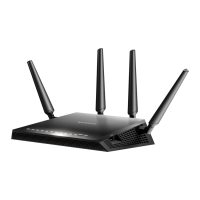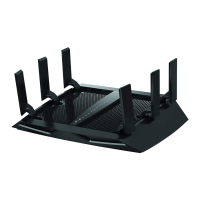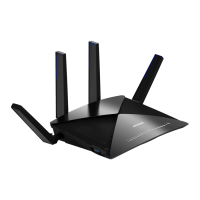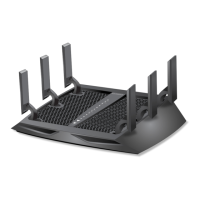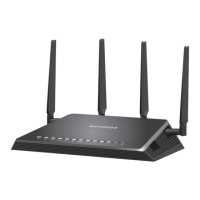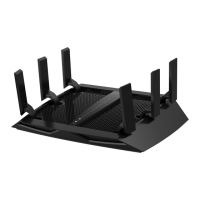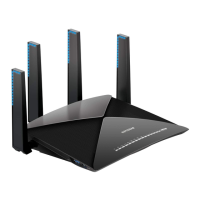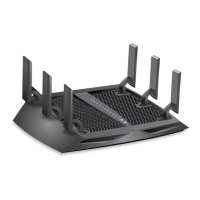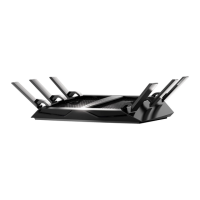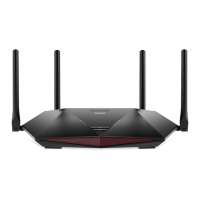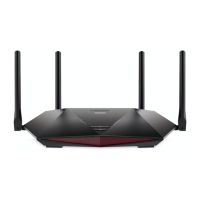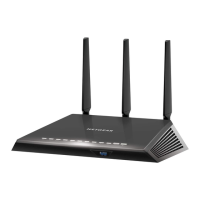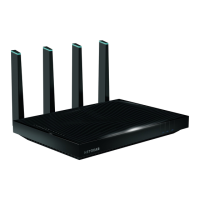
Do you have a question about the NETGEAR Nighthawk X8 AC5300 Tri-Band and is the answer not in the manual?
| Brand | NETGEAR |
|---|---|
| Model | Nighthawk X8 AC5300 Tri-Band |
| Category | Wireless Router |
| Language | English |
Details the components included in the Nighthawk X8 AC5300 Tri-Band WiFi Router package.
Describes the location of status LEDs, buttons, and USB ports on the front of the router.
Explains the location and function of the two USB ports on the right side panel of the router.
Illustrates and describes the connections and buttons located on the rear panel of the router.
Provides guidelines for optimal router placement to maximize WiFi signal range and performance.
Step-by-step instructions for connecting the router to the modem and power source.
Explains the technology behind active antennas and their role in enhancing WiFi signal.
Recommends antenna positioning based on home layout for optimal WiFi coverage.
Guides users on connecting to the router via wired Ethernet or WiFi networks.
Differentiates between ISP login, WiFi password, and router login for clarity.
Instructions for accessing the router's interface via a web browser for setup and configuration.
Explains how to change the router's interface language from the default 'Auto' setting.
Details on using the NETGEAR genie app for managing, monitoring, and repairing the home network.
Guides users through automatically detecting and setting up the router's Internet connection.
Provides detailed steps for manually configuring various Internet connection types and settings.
Instructions for configuring IPv6 connections, including Auto Detect, Auto Config, and Tunnel modes.
Explains how to adjust the Maximum Transmission Unit (MTU) size for network performance tuning.
Guides users on enabling and configuring parental controls for network content filtering.
Details how to use access control features to manage network connectivity for devices.
Explains how to block specific websites or domain suffixes using keywords.
Instructions on blocking specific Internet services based on protocol, port, or IP address.
Describes how to view, add, or remove devices from the network's allowed or blocked lists.
Allows users to define schedules for blocking websites and Internet services.
Configures the router to send email logs of router activity and security events.
Introduces tri-band WiFi technology and its speed benefits for dual-band devices.
Explains how load balancing distributes WiFi connections across bands for optimal utilization.
Highlights advantages of tri-band WiFi over dual-band, including more bandwidth and better performance.
Describes Smart Connect feature that balances 5 GHz connections across two radio bands.
Explains beamforming technology and how it improves WiFi range and performance.
Allows configuration of Wide Area Network (WAN) settings, DMZ, MTU, and ping response.
Configures a default DMZ server to improve compatibility with certain online applications.
Enables combining Gigabit Ethernet ports for improved file transfer speeds.
Guides users through changing the router's local IP address and subnet mask.
Allows customization of the router's device name displayed on the network.
Configures the range of IP addresses the router's DHCP server assigns to connected devices.
Assigns static IP addresses to specific devices to ensure consistent network identification.
Enables manual configuration of static routes for complex network routing scenarios.
Configures bridging for IPTV or other devices requiring direct ISP connection bypassing NAT.
Guides on setting up basic WiFi network name (SSID) and security parameters.
Instructions for creating a separate WiFi network for visitors with restricted access.
Enables or disables the router's WiFi radios via the web interface or the WiFi button.
Configures the router to function as a wireless access point on an existing network.
Sets up the router to extend network connectivity wirelessly, acting as a bridge.
Optimizes Internet traffic by prioritizing applications and devices for better performance.
Enables UPnP for devices like gaming consoles and media players to access the network.
Explains WMM QoS for prioritizing WiFi voice and video traffic for enhanced quality.
Guides on checking for and installing the latest router firmware for optimal performance.
Instructions for changing the default administrator password for enhanced security.
Enables password recovery options in case the administrator password is forgotten.
Displays current router status, firmware version, IP address, and network connections.
Shows detailed statistics for router ports, including status, packet counts, and bandwidth usage.
Verifies the router's current Internet connection status and IP address details.
Allows backing up, restoring, or erasing router configuration settings.
Configures the router for remote access and management over the Internet.
Explains how to use the NETGEAR genie app for remote router access and management.
Lists supported file system types and requirements for USB storage devices.
Step-by-step guide to connecting USB storage devices to the router's USB ports.
Instructions for accessing USB storage devices from Windows and Mac computers.
Guides on backing up Windows computers with ReadySHARE Vault and Macs with Time Machine.
Enables File Transfer Protocol (FTP) access for sending and receiving large files faster.
View and change network folder settings, permissions, and share names for USB devices.
Enables remote file access for USB storage devices via the NETGEAR ReadyCLOUD service.
Provides instructions on safely disconnecting USB storage devices from the router.
Guides on accessing USB devices remotely via the Internet using Dynamic DNS or IP address.
Configures FTP access through the Internet for remote file sharing and management.
Explains Dynamic DNS and how to set up a new account or use an existing one.
Allows modification of the router's Dynamic DNS account settings as needed.
Configures the router to act as a DLNA media server for compatible devices.
Guides on playing music from USB storage via iTunes Server on Windows or Mac computers.
Explains setting up the iTunes Server for music playback using the Apple Remote app.
Instructions for setting up the router to work with TiVo for media playback.
Guides on installing printer drivers and the ReadySHARE Printer Utility for network printing.
Details on using the NETGEAR USB Control Center for managing print jobs and queues.
Explains how to check and change the connection status of a shared USB printer.
Covers settings for disabling automatic startup, changing language, and specifying time-outs.
Establishes a secure Virtual Private Network (VPN) connection for remote network access.
Provides instructions for downloading and installing OpenVPN client software on a computer.
Guides on opening a VPN tunnel from a computer to the router for secure Internet access.
Enables remote access to the router's USB devices and media content through a VPN connection.
Allows VPN clients to use the home network's Internet service while away from home.
Configures port forwarding rules to allow specific incoming traffic to reach local servers.
Provides procedures for modifying or removing existing port forwarding configurations.
Explains port triggering for dynamic opening of ports based on outbound traffic.
Guides on enabling and configuring port triggering settings for enhanced network access.
Provides basic troubleshooting tips and the correct sequence for restarting the network.
Guides on checking physical connections and ensuring correct network/WiFi settings.
Explains standard LED behavior and troubleshooting using router LEDs.
Addresses common problems like inability to log in or access the Internet.
Provides steps for troubleshooting Internet browsing problems and PPPoE connections.
Helps resolve issues with unsaved changes and problems connecting to WiFi networks.
Introduces using utilities like Ping to diagnose network connectivity issues.
Details the default factory settings and how to restore them using the Reset button.
Provides comprehensive technical specifications for the router hardware and features.
